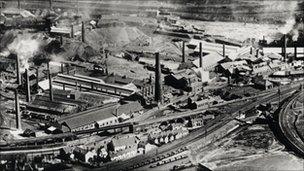Historians urge Swansea to cash in on copper legacy
- Published
In the heat of the industrial revolution, copper put Swansea on the map.
In its heyday, the city produced 40% of the world's output, earning the nickname Copperopolis.
The first copper ingot was produced at Swansea's historic Hafod Copperworks site 201 years ago and continued until 1980.
Now academics from around the world have gathered to examine how the city's success in the 19th century can be applied today.
Historian Dr Chris Evans said its future lay with its "considerable" engineers and scientists.
"Heavy industry may have gone, but the future for the city lies in high value goods produced by its considerable skill base of engineers and scientists," he added.
"In the 1830s, it required three tons of coal to smelt one ton of copper ore, so thanks to Swansea's easily navigable docks and proximity to the south Wales coalfields, it made economic sense to bring the ore to the coal in Wales.
'Diversify'
"But by the end of the century smelting technology had advanced to the stage whereby the ratio of coal to copper was near enough one-to-one.
"That obviously challenged Swansea's dominance, but it was a challenge to which they rose."
By the early 1900s the United States had overtaken Swansea as the dominant force in basic smelting.
However, Swansea used its expertise to diversify in to chemical and production processes, which kept them relevant in the copper industry until the mid to late 20th century.
Dr Evans, who is leading a global conference of the project World of Copper: Globalising the Industrial Revolution, 1830-1870, added: "That's a lesson which Swansea is trying to learn to this day."

Swansea produced 40% of the world's output, earning the nickname Copperopolis
The historians are all part of the World of Copper project, which is expected to run for 18 months. They will have travelled from Chile, Australia, North America and Germany.
"That's a measure of the interest around the world which there is in this small town which played such a huge role in the Industrial Revolution," Dr Evans said.
It is funded by the Leverhulme Trust, which looks at Swansea's world-renowned copper industry as an example of globalisation in the 19th century.
Dr Evans believes that Swansea's legacy has not been exploited.
"For so many years the copper industry was something which Swansea was almost embarrassed about," he said.
"The lack of vegetation in the lower Swansea valley and the derelict Hafod site were things the city would rather forget not celebrate," he said.
"But with the help of Cadw; the project is aiming to transform the area in to the sort of visitor attraction which will finally allow the city to cash in on the potential tourist trade which its history deserves."
- Published2 December 2011
- Published5 March 2011